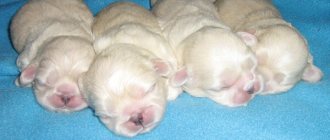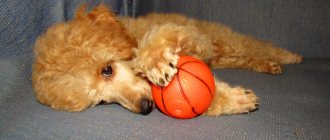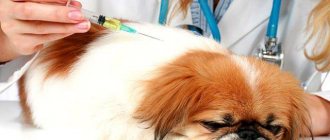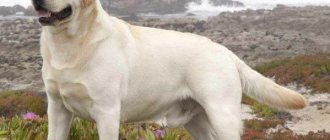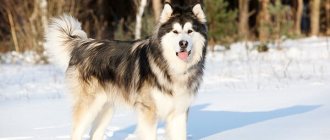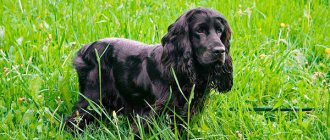From childhood, Pekingese puppies are calm, phlegmatic and stubborn.
These small dogs are often capricious and disobedient, but at the same time they are well aware of the owner’s mood and know how to adapt to it.
Since childhood, such a dog is quite self-sufficient; he will never impose himself or fulfill demands that he does not like.
Pekingese puppies are difficult to train and can only master the simplest commands.
Photos of newborn puppies
The neonatal period for Pekingese puppies lasts approximately 12 days.
Immediately after birth, babies are completely helpless and are unable to see, hear, or empty their bowels and bladder. A newborn is only able to respond to smell, temperature and touch. In addition, it does not have thermoregulation and is heated by the mother. Babies' eyes open 12-15 days after birth.
The weight of a newborn is 150-250 g, height 15-20 cm. However, the size of the babies may vary depending on how many puppies the bitch gives birth to.
Development from 1 to 12 months
| Pet age | Size | Weight | Description |
| 1 month | 15-20 cm in length | At the end of the period - weight 500-700 g. | In the first month of life, the puppy feeds on its mother's milk. Starting from 3 weeks of age, the dog already shows interest in solid food. A Starting from 14 days, his eyes and ears come off, and his intestines begin to work independently. |
| 2 months | 25-35 cm in length | 800-1100g | The baby masters the principles of social behavior, he has already developed all physiological functions, and he also completely switches to solid food. In the middle of the 2nd month, the puppy is gradually weaned from its mother. |
| 3-4 months | 8-10 cm at the withers | 1.2-2 kg | The baby's teeth begin to change, and signs of character also appear. At this age, the pet awakens to its individuality. |
| 4-6 months | 10-12 cm at the withers | 2-5 kg | The dog gains significant height and weight, and also begins to show interest in the opposite sex. |
| 7-9 months | 12-15 cm at the withers | 3-6 kg | Now this is a teenage dog, the pet’s character and habits have already been practically formed, and active hormonal changes associated with puberty begin in the body. |
| 10-12 months | 15-25 cm at the withers | 5-7 kg | At this age, females begin their first heats, and males become more active, marking their territory and trying to take a higher place in the hierarchy. |
Brief description of the breed
The Pekingese is an imperial breed. Previously, only the nobility had such animals. If such a dog was stolen, the attacker was punished by execution. The breed comes from Beijing (hence its name).
Appearance standards:
- Large head with a flattened and wide skull.
- Big round eyes.
- Black eyelids.
- Flat muzzle with black nose.
- Heart-shaped ears with elongated hair.
- Thick and short neck.
- The front part of the body is powerful, developed chest.
- Slim waist.
- Flattened and crooked paws.
- High-set tail with thick, long hair.
- Weight – from 2.5 to 5.5 kg.
- Dense undercoat.
- Height at the withers is 10-25 cm.
The traditional color is red. But there are animals with black, sandy, white, gray or spotted fur.
Dogs are distinguished by high intelligence, good nature, fearlessness and activity. They are friendly and loyal to their owners. But they are characterized by arrogance and stubbornness.
Basic care rules
Rules for caring for a Pekingese puppy include:
- Brushing with the help of special brushes and combs; you need to comb your baby daily to avoid the appearance of tangles.
- Daily walks for 30-40 minutes 3 times a day.
- The puppy is bathed as needed using a special shampoo and conditioner for coarse coats.
- You can cut your pet's hair starting from 6 months of age. Approximately once every 2 months, cosmetic haircuts should be performed, paying special attention to the paw pads and the space between the toes.
- Eye care must be performed with special care due to their structure. The Pekingese's eyes have a shortened tear duct, so they are susceptible to inflammation and injury, which means that they need to be wiped daily with a cotton pad and a special solution. Also, the puppy's eyes should be examined daily for inflammation of the tear ducts.
- Nails are trimmed once every 2 weeks using a special nail clipper.
- Regular examination by a veterinarian (at least every six months) is an integral part of good care.
- Timely vaccination according to schedule.
- Carrying out deworming and antiparasitic treatment.
Character traits
The Dwarf Pekingese has a calm character and is characterized by a lack of aggression and fearlessness.
These dogs quickly become attached to the owner and need his attention, but they will never impose themselves, because they are quite independent and have the ability to capture his mood, understanding when it is better to stay away.
Miniature representatives of the breed do not like long walks, noisy companies and active games, so they will become excellent pets for people accustomed to leading a measured and calm lifestyle.
Due to their dislike of noise and activity, the Miniature Pekingese is not the best option for families with small children. Such a pet will not only not be able to share the baby’s enthusiasm, but will also try to stay away from him.
They can get along with other pets only on the condition that the owner, no matter what, will pay maximum attention to them and not to other animals, otherwise aggression is possible, although it is not typical for these dogs.
Mini Pekingese are not easy to train. These dogs are smart, but too stubborn and willful, and a disrespectful attitude and, especially, physical punishment will lead to the opposite result and destructive behavior of the pet, so the owner should be patient and self-control.
Expert opinion
Kozhevin Semyon Kirillovich
Expert dog handler.
Pocket Pekingese can be described as intelligent and quick-witted, but also stubborn, headstrong, touchy and proud dogs. They need the attention, love and affection of their owner and, if they do not receive this, they begin to feel sad and fall into a kind of depression, which entails a refusal of water and food. We must not forget that Pekingese have long been accustomed to special treatment, so they can be quite selfish - for these dogs this character trait is quite normal.
How to toilet train?
Given the innate stubbornness of the Pekingese, babies should be toilet trained exclusively through interest and encouragement. In the beginning, you should use a diaper or tray with filler.
From the first days of your dog's stay in the house, you should show him the place where he needs to defecate. At the initial stage, you can use several diapers or trays and place them in those places where the puppy most often does his business. He should have a clear association with the litter box and emptying. After a while he himself will look for it.
The second stage is toilet training outside. You can do this from the very first walks. To do this, you need to walk with the baby until he goes to the toilet, and then praise him and treat him with a treat. The goal is to reinforce in the dog’s mind that defecating on the street is associated with positive emotions.
NOTE!
When training a Pekingese, you should not use a punishment system; these dogs simply will not understand this approach and the result will be the opposite.
Origin story and what it looks like in the photo
Pekingese are dogs originally from China, which were bred by crossing representatives of the ancient Chinese decorative breed “Toy” with larger dogs.
Only representatives of the upper class were allowed to keep them, so the Pekingese always lived only in palaces and had personal servants.
Representatives of this breed have never been guards, watchmen or hunters. Their main purpose was to please and amuse their owners, and in temples they were worshiped as deities and considered a symbol of prosperity and happiness.
The coup d'etat in China had a negative impact on the Pekingese population - the rebels burned the imperial mansions to the ground, and the representatives of the breed who lived in them died. The British military managed to rescue several dogs and transport them to Europe.
In England, Pekingese quickly gained popularity, but they still remained dogs that were not accessible to everyone - the price of puppies was too high for ordinary people.
The breed acquired its official name only at the end of the 19th century, simultaneously with its recognition by dog handlers.
It should be understood that Royal Pekingese are not a separate breed . This is how breeders call individuals who ideally meet the standard, which, by the way, does not strictly regulate the height and minimum weight of adult dogs, but only describes the average acceptable indicators.
What to feed for the first 3 months?
In the first 3 months, the baby should be fed only natural food, which should include:
- Boiled lean meat minced in a meat grinder.
- Boiled eggs.
- Fresh or stewed vegetables that do not cause bloating (beets, carrots, zucchini, cucumber, etc.).
- Fermented milk products (kefir, yogurt, yogurt, cottage cheese).
- Lean sea fish without bones.
- Oatmeal, buckwheat or rice porridge.
Nutritional Features
The choice of food type depends on the owner . These can be natural products or ready-made dry food - the main thing is that the diet is balanced.
The advantage of natural feeding is the ability to choose products for your pet and control their quality. In addition, nutrients of natural origin are better absorbed by the dog’s body.
Royal Pekingese should be included in the menu:
- offal;
- lean meat;
- cereals;
- fruits, herbs and vegetables;
- sea fish;
- dairy and fermented milk products.
It is forbidden to feed representatives of this breed:
- bones;
- sweets;
- fatty meat;
- legumes;
- fried, smoked, salted, spicy and pickled foods;
- exotic fruits;
- baked goods;
- pasta.
IMPORTANT!
Additionally, you should give your pet a complex of vitamins and minerals.
Dry food is more convenient to use and store, and also does not require additional intake of a vitamin-mineral complex. You should choose food from products of at least premium class, taking into account the age, health and physiological state of the pet.
The most suitable food for Royal Pekingese: Happy Dog, Acana, Artemis, Almo Nature, Canidae, Orijen, 1st Choice, Royal Canin, Arden Grange, Brit Premium.
How to feed?
A 2-month-old puppy is usually fed 6 small meals a day.
At 3-4 months old, a baby can already eat 4-5 times a day, with portions being slightly increased.
From 5 to 9 months the pet is fed 3 meals a day.
And from 10 months he is fed 2 times a day, morning and evening.
Menu for the week
Monday:
- Breakfast – oatmeal with liver.
- Lunch – boiled beef.
- Dinner - cottage cheese.
Tuesday:
- Breakfast - curdled milk.
- Lunch – rice porridge with heart.
- Dinner - stewed zucchini and a piece of fish.
Wednesday:
- Breakfast - boiled egg.
- Lunch – heart or liver with buckwheat.
- Dinner – baked pumpkin with rice.
Thursday:
- Breakfast - yogurt.
- Lunch – veal with fresh carrots.
- Dinner – rice porridge with stewed beets.
Friday:
- Breakfast – boiled carrots with a piece of fish.
- Lunch – buckwheat porridge with heart or tripe.
- Dinner – cottage cheese or kefir.
Saturday:
- Breakfast – veal with fresh cucumber.
- Lunch – oatmeal with yogurt.
- Dinner – stewed zucchini.
Sunday:
- Breakfast - cottage cheese or yogurt.
- Lunch – beef tripe with rice porridge.
- Dinner – baked pumpkin.
Vaccination schedule
The first vaccinations for puppies are usually given by the breeder, and the rest should be taken care of by the new pet owner.
| Pet age | Vaccination |
| 2 months | The pet is vaccinated against leptospirosis, distemper, hepatitis, adenovirus infection, parvovirus enteritis, and proto-influenza. |
| 3 months | Revaccination against the same diseases. |
| 6 months | Rabies vaccine is administered. |
| 12 months | Vaccinations are repeated. |
| Annually | The dog receives the same set of vaccinations throughout its life. |
Hygiene procedures
It is recommended to bathe a Pekingese puppy from 6 months of age and only if the dirt is too strong. If this is not the case, then it is better to manage with dry shampoo and combing.
But if your pet still needs to be bathed, then the following rules should be followed:
- The water for bathing should be approximately 38-39 degrees, and its amount should reach the puppy approximately to the knee, so as not to cause fear.
- The room should be warm and there should be no drafts.
- When bathing, it is advisable to use shampoo designed specifically for puppies of long-haired breeds.
- After bathing, the baby is wrapped in a soft towel, dried thoroughly, and then dried with a hairdryer.
- You cannot walk with your baby for 3 hours in the swimming area, and you should also protect him from drafts.
In addition to bathing, caring for Pekingese puppies includes:
- Weekly brushing of teeth using a specially designed dog brush and toothpaste.
- Inspect the ears daily for dirt and inflammation, as well as weekly cleaning with a dry cotton swab.
- Nails are trimmed once every 2-3 weeks using a special nail clipper.
- Hair combing is done daily using special brushes and combs.
Advantages and disadvantages
It is generally accepted that representatives of decorative breeds, including Pekingese, are suitable for almost everyone. However, this is not entirely true, therefore, when thinking about purchasing a Royal Pekingese, you should familiarize yourself with the advantages and disadvantages of these dogs in advance.
The advantages of the Royal Pekingese include::
- unusual, attractive appearance;
- devotion;
- ability to withstand cold;
- fairly good health;
- possibility of apartment maintenance;
- calm character;
- no need for long walks and physical activity;
- unpretentiousness in food.
Among the disadvantages of the breed are noted:
- stubbornness and willfulness;
- jealousy;
- excessive independence;
- snoring and sniffling;
- heat intolerance;
- need for attention.
In addition, Pekingese require careful grooming and are characterized by heavy seasonal shedding.
How to choose your future pet?
Before you make your choice, you should think about why you need a puppy and what class of pet you need.
If you just need a pet, then a pet-class dog is quite suitable. If the goal is breeding, but you need a puppy of at least breed class level. If you want your dog to take prizes at exhibitions, you will have to purchase a show-class pet and this will not be cheap.
In addition, the dog must have all the necessary documents and a veterinary passport.
The next stage is choosing a seller. Under no circumstances should you buy a puppy at a poultry market or online. You must see the dog in person, talk to the breeder, and also evaluate the conditions in which the dogs live in the kennel.
If the breeder is not ready to provide the necessary documents, then most likely the puppy was born as a result of an unscheduled mating, and subsequently you will not be able to prove its origin. Such a dog has no access to exhibitions and breeding work and is only suitable as a pet.
At the same time, a conscientious breeder is always ready to provide all the necessary documents and information, as well as help after the purchase.
The next step is to examine the puppy itself.
Signs of a healthy pet:
- The eyes are clear, shiny without discharge or inflammation.
- Clean nose and ears.
- Shiny and shiny coat.
- The puppy must be active and inquisitive.
- The pet's limbs must be strong and healthy; lameness is unacceptable.
IMPORTANT!
Before purchasing, it is very advisable to examine the baby’s parents and assess their condition. In addition, you should see their pedigrees and veterinary records.
Price range
The price of Pekingese puppies may vary depending on the pedigree and class of the pet.
So a pet-class puppy will cost an average of 5-9 thousand rubles.
A breed-class baby costs 10-15 thousand rubles.
A show-class dog costs 18 to 20 thousand rubles.
Also, prices depend on the region and the status of the nursery.
Life expectancy, health and major diseases
On average, Royal Pekingese live 12-15 years, with some individuals known to live up to 20 years.
Most often, representatives of this breed are diagnosed with:
- problems with the spine;
- urolithiasis;
- skin and cardiovascular diseases;
- cataract;
- conjunctivitis;
- inflammation of the tear ducts;
- renal failure;
- hydrocephalus.
In addition, Pekingese are dogs with a brachycephalic skull structure, which causes breathing problems, especially in the heat and in case of excessive physical exertion.
